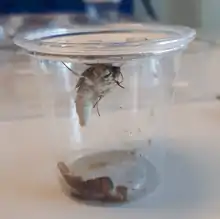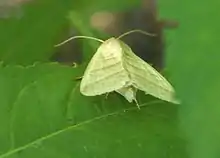Chloridea subflexa
Chloridea subflexa is a moth of the family Noctuidae first described by Achille Guenée in 1852. It is found from most of the United States, throughout the Antilles, and south to Argentina.[1]
| Chloridea subflexa | |
|---|---|
 | |
| Chloridea subflexa seconds after hatching | |
| Scientific classification | |
| Kingdom: | Animalia |
| Phylum: | Arthropoda |
| Class: | Insecta |
| Order: | Lepidoptera |
| Superfamily: | Noctuoidea |
| Family: | Noctuidae |
| Subfamily: | Heliothinae |
| Genus: | Chloridea (Guenée, 1852) |
| Species: | C. subflexa |
| Binomial name | |
| Chloridea subflexa (Guenée, 1852) | |
| Synonyms | |
| |

The larvae feed exclusively on fruits of Physalis species, which are enclosed in an inflated, lantern-shaped calyx. To feed, each newly emerged caterpillar cuts a small hole in the calyx and then bores into the fruit. Once inside, the caterpillar spends the majority of its time sheltered inside of the fruit's husk.
Chloridea subflexa was formerly a member of the genus Heliothis, but was moved to the reinstated genus Chloridea as a result of genetic and morphological research published in 2013.[1]
The MONA or Hodges number for Chloridea subflexa is 11070.[2]
References
- Pogue, Michael G. (2013). "Revised status of Chloridea Duncan and (Westwood), 1841, for the Heliothis virescens species group (Lepidoptera: Noctuidae: Heliothinae) based on morphology and three genes" (PDF). Systematic Entomology. 38. doi:10.1111/syen.12010.
- "North American Moth Photographers Group, Chloridea subflexa". Retrieved 2020-12-15.
External links
- Determinants of host use and fitness of Heliothis subflexa, a specialized herbivore
- Moths of Belize
- "Heliothis subflexa (Guenée, 1852)". Catalogue of the Lepidoptera of the French Antilles. Retrieved September 16, 2019.
- Large moths of Guana Island, British Virgin Islands: a survey of efficient colonizers (Lepidoptera: Sphingidae, Notodontidae, Noctuidae, Arctiidae, Geometridae, Hyblaeidae, Cossidae)